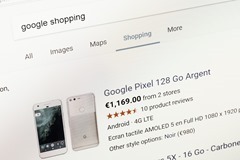Imagine walking into a department store in which the salespeople are indifferent to your presence. They aren’t willing to help you find the product you seek, let alone answer any questions about it. Now, think about your ecommerce site. If it seems indifferent to shoppers in the same way, they will be unlikely to buy from you. If you want to motivate customers to make purchases, consider these product page best practices.
Demonstrate Trustworthiness
When a visitor arrives at your ecommerce site, they assess its professionalism in an effort to determine its trustworthiness. Nice photography, an attractive page design, and copy free of spelling, grammatical and punctuation errors are key indicators. Testimonials from previous buyers, ideally with photos of them using the product, will also help reassure visitors your store is legitimate. Trust badges from entities like McAfee, PayPal, the Better Business Bureau and VeriSign say you’ve also put in the work to ensure your customers’ personally identifiable information is safe.
Make Your Pictures Tell Stories
Your pictures should be appetizing to the viewer. Make them large and sharply focused. They should also be composed in a way that makes them as descriptive as possible of the merchandise. If you sell electronics for example, run a large image of the product to attract the shopper’s eye. Supplement this with clickable thumbnails of as many different relevant angles as possible. You should also provide extreme close-ups of key details such as the controls, connectors and the like.
Deliver Thorough, Yet Concise Product Descriptions
The copy you run with those images should describe the product in enough detail for the shopper to confirm it’s what they need. However, you should also avoid providing so much information they get bogged down in minutiae. When you’re developing the pages, keep the nature of your ideal customer in mind. Who are they? Why are they likely to want the product? What’s great about the product? How can it improve their lives? What guarantee would compel them to make a purchase? Provide answers to these questions in everyday down-to-earth language that helps them see themselves using the product. If your product is technical in nature, give them a bulleted list of key specifications too and you should be good to go.
Imply Scarcity
People hate the idea of missing out on a great deal. If you’re offering a special price, make sure shoppers know it’s for a limited time only by conveying that information on your product page. When the item is in short supply, show them how many are left in stock and indicate how many other people are looking at the product. The idea is to give them the impression they could miss out if they don’t act quickly.
Post A Clear Call To Action
Every product page should feature a prominent “But It Now” button in a color that is contrasting, yet pleasing to the eye. Failing to do so is like hiding the checkout stand in a department store. You’ll leave your customer wandering all over the place trying to figure out how to pay for the product.
Prioritize Mobile
Mobile is huge and growing all the time. Your pages should incorporate responsive design so they look good on any type of device. They should also load quickly, as mobile shoppers tend to be less patient than desktop shoppers. Because you’re working with a smaller screen, you’ll need to use it strategically. Always lead with a compelling image and make sure the product description is large enough to be easily read on a handheld device.
These product page best practices will ensure your site is a helpful place where customers are led by the hand to the products they seek. What’s more, when they get there, all of their questions are answered. Stores like this tend to develop loyal followings of repeat customers.

